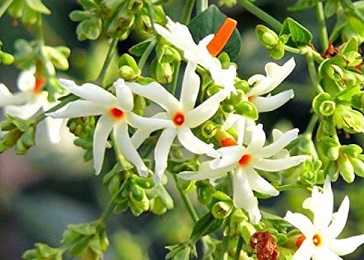Silico Study Reveals Potential Antiviral Properties Of Nyctanthes Arbor-Tristis Linn Against Ebola, SARS2, Nipah & Chikungunya Viruses
Nikhil Prasad Fact checked by:Thailand Medical News Team May 03, 2024 1 year, 6 months, 3 weeks, 4 days, 11 hours, 1 minute ago
Herbs And Phytochemicals: Nyctanthes arbor-tristis, commonly known as the Night-flowering Jasmine or Parijat, is a plant with a rich history in traditional medicine. This
Herbs And Phytochemicals news report delves into recent research conducted by institutions in Saudi Arabia, unveiling the plant's potential antiviral properties against notable viruses like Ebola, SARS-CoV-2 (the virus causing COVID-19), Nipah, and Chikungunya. Through computational analysis and molecular dynamics simulations, scientists have identified promising phytochemicals within Nyctanthes arbor-tristis Linn, paving the way for further exploration in antiviral drug development.
 Silico Study Reveals Potential Antiviral Properties Of Nyctanthes
Silico Study Reveals Potential Antiviral Properties Of Nyctanthes
Arbor-Tristis Linn Against Ebola, SARS2, Nipah & Chikungunya Viruses
Unraveling the Botanical Treasure: Nyctanthes arbor-tristis Linn
Nyctanthes arbor-tristis, a member of the Oleaceae family, is native to regions in South and Southeast Asia, including India and Nepal. Its therapeutic properties have long been recognized, attributed to a diverse array of phytochemicals found in its leaves, stems, and flowers. These compounds, such as glycosides, flavonoids, and aromatic oils, showcase a spectrum of biological activities, from hepatoprotective and antimicrobial to anti-inflammatory and antiviral effects. The plant's historical uses and chemical composition set a promising stage for investigating its antiviral potential.
Urgency Amid Viral Pandemics: Contextualizing the Need for Antiviral Solutions
The emergence and rapid spread of viral diseases like COVID-19, Ebola, Nipah, and Chikungunya have underscored the critical need for effective antiviral therapies. Traditional approaches, coupled with modern computational tools, offer a pathway to identify novel antiviral compounds. The article emphasizes the significance of natural sources like Nyctanthes arbor-tristis in this quest, especially considering challenges such as vaccine accessibility and viral mutations.
Computational Insights: Evaluating Nyctanthes arbor-tristis Against Viral Targets
Researchers employed computational methodologies to analyze phytochemicals from Nyctanthes arbor-tristis Linn and their interactions with key viral proteins. Through virtual screening and molecular docking analyses, compounds like arborside-C, beta amyrin, and beta-sitosterol exhibited notable binding affinities to specific viral targets. Comparisons with standard antiviral drugs like remdesivir highlighted the potential efficacy of these natural compounds.
Key Findings
Findings from virtual screening and AutoDock analysis demonstrate notable affinity of certain compounds like arborside-C, beta amyrin, and beta-sitosterol towards specific viral targets. Arborside-C and beta-sitosterol displayed binding energies of -8.65 and -9.11 kcal/mol, respectively, when interacting with the primary protease, compared to remdesivir'
;s -6.18 kcal/mol. Other targets showed -7.52 kcal/mol for beta-amyrin against Ebola and -6.33 kcal/mol for nicotiflorin against Nipah virus. Further molecular dynamics simulations on promising compounds like the beta-amyrin-VP35 complex exhibited stable RMSD patterns, indicating potential antiviral efficacy. In summary, arborside-C, beta-sitosterol, beta-amyrin, and nicotiflorin stand out as promising natural antiviral agents sourced from Nyctanthes arbor-tristis Linn, making it a compelling subject for future in vitro and in vivo investigations.
The study focused on pivotal viral proteins such as Ebola's VP35, SARS-CoV-2 protease, Nipah virus glycoprotein, and Chikungunya virus nsP2 protease. Detailed analyses elucidated how phytochemicals from Nyctanthes arbor-tristis interacted with these targets, inhibiting crucial viral functions like interferon synthesis, viral entry into host cells, and protease-mediated infectivity. Molecular dynamics simulations provided insights into stability and binding patterns, reinforcing the compounds' potential as antiviral agents.
Comparative Analysis and Future Prospects
Comparative analyses with existing antiviral drugs underscored the competitive binding affinities and potential advantages of Nyctanthes arbor-tristis-derived compounds. The discussion delves into molecular dynamics, ADME (absorption, distribution, metabolism, excretion), and drug-likeness analyses, emphasizing the need for further experimental validations and clinical studies to translate these computational findings into tangible antiviral therapies.
Conclusion: Nyctanthes arbor-tristis Linn as a Promising Antiviral Resource
In conclusion, the collaborative efforts of research institutions in Saudi Arabia have unveiled Nyctanthes arbor-tristis Linn as a compelling natural source of antiviral compounds. The article synthesizes computational findings, botanical knowledge, and virology insights, highlighting the plant's potential in combating diverse viral infections. Future investigations, including in vitro and in vivo studies, are warranted to harness the therapeutic benefits of Nyctanthes arbor-tristis in the global fight against viral pandemics.
The study findings were published in the peer reviewed journal: Pharmaceuticals.
https://www.mdpi.com/1424-8247/17/5/581
For the latest on
Herbs And Phytochemicals, keep on logging to Thailand Medical News.
